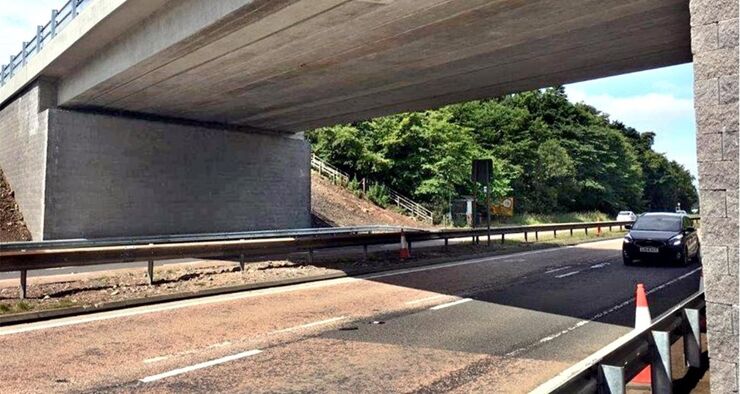
The City of Edinburgh Council has used NEC contracts to rebuild a key bridge over the A90 dual carriageway that links Edinburgh to the M90 motorway and northern Scotland. The new Burnshot Bridge re-opened a direct link to the city from Kirkliston in the west, which had been closed for 4 years.
The reinforced concrete deck of the original 1964 bridge used half-joints, which are no longer permitted in current design codes. Following continuing deterioration of these joints, the bridge was restricted to single-lane traffic and was eventually closed in 2016.
The Council engaged Balfour Beatty Civil Engineering Limited through Scape Group, which uses NEC contracts in its single-supplier frameworks, to demolish the bridge and design and build a replacement. Demolition was carried out between October and December 2017 via Scape’s 2015 £1.5 billion National Civil Engineering and Infrastructure Framework under an NEC3 Engineering and Construction Contract (ECC) Option A (priced contract with activity schedule). The design was let via the same framework under an NEC3 Professional Services Contract (PSC) Option A.
Construction work was then let in May 2019 via Scape Procure Scotland’s 2018 £0.5 billion Civil Engineering − Scotland framework under a £3.5 million NEC4 ECC Option A. Aside from the onset of the Covid-19 pandemic in March 2020, which stopped all work until June, the project was completed within budget and on programme in July 2020. The Council acted as NEC project/service manager for all contracts and the contractor’s designer was Mott MacDonald.
The new bridge is an integral 33 m single-span structure with concrete spread foundations supporting in situ concrete piers clad with masonry. The 15.5 m wide deck and diaphragms act compositely with the precast Y5 main beams, and stainless-steel reinforcement has been used throughout to achieve a 120 year design life and minimise whole-life cost. The bridge carries the single-carriageway Burnshot Road as well as 4 m wide pedestrian and cycle paths each side that link into National Cycle Network route NCN1.
Popular Contracts
Project manager Stephen Knox says it became critical to demolish the bridge before the onset of winter in 2017 as it was uncertain whether its deteriorating joints would survive another season of freeze-thaw cycles.
‘Using the NEC-based Scape framework, we were able to let the demolition, design and construction works quickly and efficiently using popular, industry-recognised contracts. The popularity of the NEC suite contracts also facilitated the use of a contract management portal to efficiently manage the administration of the contract. Furthermore, the excellent support and training provided by NEC gave confidence to all of us involved in managing the contract.’
Knox says the flexibility and collaborative ethos of NEC facilitated early engagement of precast beam and reinforced-soil suppliers during the design phase. ‘This minimised the risk from contractor-designed elements during construction which, due to the geometrical challenges of the site, probably saved us around 3 months.’
He says the contractor’s proposal mechanism in NEC4 ECC encouraged the contractor to propose value-engineering solutions during construction. ‘Due to additional information gained following mobilisation on site, value-engineering resulted in savings being made on drainage works, benefiting both the contractor and client.’
According to Knox, the fixed-price arrangement in Option A gave budget confidence to elected Council members. ‘Excluding the unforeseen effects of Covid-19, the overall project was completed under budget. The mechanism for regular programme submission, review and acceptance by the project manager encouraged the contractor to review and rearrange activities when it became apparent that the planned completion date exceeded the completion date, resulting in the bridge opening on time.
‘The NEC4 ECC construction contract also provided a clear mechanism by which to deal with the Covid-19 suspension period and the additional costs associated with this.’
He adds that the collaborative ethos of NEC extended to relationships with the local community. ‘Local people and interest groups were involved throughout the project during regular engagement events in the local library, where they could view models of the bridge and understand the construction sequence without needing to visit site.’
Benefits of Using NEC
- NEC popularity meant there was a wide network of support, which in turn helped to ensure the demolition, design and construction contracts were all managed efficiently.
- All three NEC contracts encouraged the parties to work collaboratively and had clear workflows to manage early warnings, compensation events and programmes.
- NEC4 ECC encouraged the contractor to propose value-engineering solutions during construction and provided a clear mechanism to deal with the Covid-19 suspension and associated costs.




